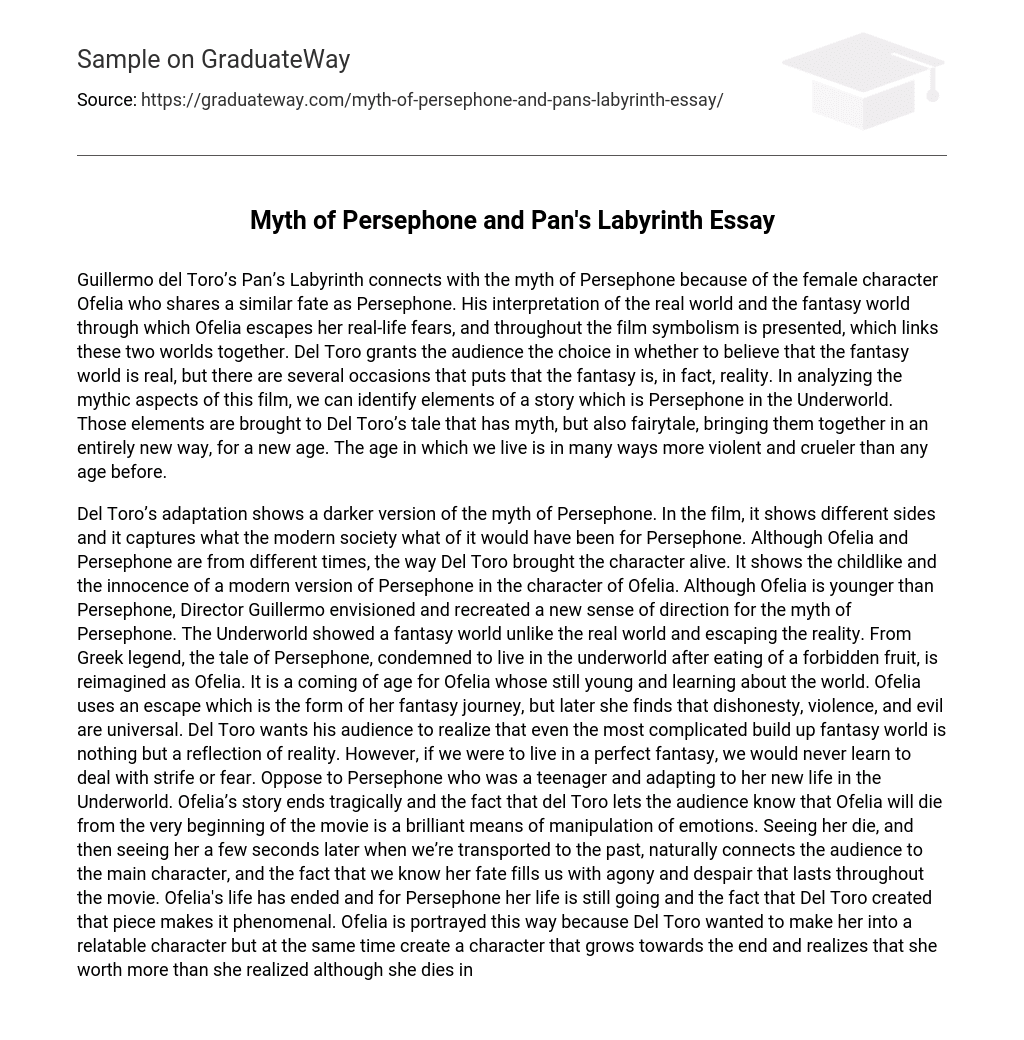Guillermo del Toro’s Pan’s Labyrinth connects with the myth of Persephone because of the female character Ofelia who shares a similar fate as Persephone. His interpretation of the real world and the fantasy world through which Ofelia escapes her real-life fears, and throughout the film symbolism is presented, which links these two worlds together. Del Toro grants the audience the choice in whether to believe that the fantasy world is real, but there are several occasions that puts that the fantasy is, in fact, reality. In analyzing the mythic aspects of this film, we can identify elements of a story which is Persephone in the Underworld. Those elements are brought to Del Toro’s tale that has myth, but also fairytale, bringing them together in an entirely new way, for a new age. The age in which we live is in many ways more violent and crueler than any age before.
Del Toro’s adaptation shows a darker version of the myth of Persephone. In the film, it shows different sides and it captures what the modern society what of it would have been for Persephone. Although Ofelia and Persephone are from different times, the way Del Toro brought the character alive. It shows the childlike and the innocence of a modern version of Persephone in the character of Ofelia. Although Ofelia is younger than Persephone, Director Guillermo envisioned and recreated a new sense of direction for the myth of Persephone. The Underworld showed a fantasy world unlike the real world and escaping the reality. From Greek legend, the tale of Persephone, condemned to live in the underworld after eating of a forbidden fruit, is reimagined as Ofelia. It is a coming of age for Ofelia whose still young and learning about the world. Ofelia uses an escape which is the form of her fantasy journey, but later she finds that dishonesty, violence, and evil are universal. Del Toro wants his audience to realize that even the most complicated build up fantasy world is nothing but a reflection of reality. However, if we were to live in a perfect fantasy, we would never learn to deal with strife or fear. Oppose to Persephone who was a teenager and adapting to her new life in the Underworld. Ofelia’s story ends tragically and the fact that del Toro lets the audience know that Ofelia will die from the very beginning of the movie is a brilliant means of manipulation of emotions. Seeing her die, and then seeing her a few seconds later when we’re transported to the past, naturally connects the audience to the main character, and the fact that we know her fate fills us with agony and despair that lasts throughout the movie. Ofelia’s life has ended and for Persephone her life is still going and the fact that Del Toro created that piece makes it phenomenal. Ofelia is portrayed this way because Del Toro wanted to make her into a relatable character but at the same time create a character that grows towards the end and realizes that she worth more than she realized although she dies in the end. But she sent to the Underworld and is living the life she was meant to have with the people she cares about.
Persephone’s story of temptation is analogous to Pan’s labyrinth. Respectively, Ofelia is tempted by fruit. She has had minimal independent thought before this point in the film, and in making a childish decision to eat the fruit, Ofelia is much closer to womanhood. This connects with Persephone who also faced this similar situation and acted on temptation. In which to say that Ofelia is captured as Persephone and had to grow to understand what is in store for her good or bad. The outcome of childhood to maturity and faced the challenges given to her. They both had to grow up and understand the values of life and the decisions along the way.
Pan’s Labyrinth connection with myth of Persephone brings the character of Ofelia as reimagined as Persephone. This brings Del Toro ‘s interpretation in fantasy, reality, childhood innocence, maturity, and fairytales into light. The film adaptation was more dark, mythical, more cruel, and brought the image well.





